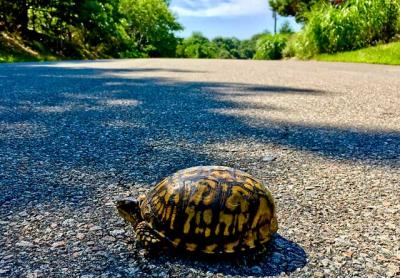Nature Notes: Brake for Turtles

It’s turtle time. Female diamondback terrapins are coming ashore to lay eggs and female box turtles are walking into people’s yards to dig out a nest and lay their own. June is their month of choice; May is a close runner-up. If not disturbed or discovered by a raccoon, the eggs hatch at the end of August. The little turtles — not much bigger than a quarter but turtles in all other respects — dig themselves out. The baby diamondbacks head for the water, while the baby box turtles head for the nearest woods.
Karen Testa, the executive director of Turtle Rescue of the Hamptons, a 2012 spinoff from the Evenlyn Alexander Wildlife Rescue of the Hamptons, says she is getting 9 or 10 calls a day about turtles in need. During my last call to her facility in Jamesport on the North Fork, she got one of her “turtle-in-trouble” calls and had to break off the conversation to attend to a turtle in distress.
We have several turtles native to Long Island. The box turtle, while it may submerge itself in water to keep cool on the hottest days, is a bona fide terrestrial turtle. The others are aquatic. Of these, the diamondback is the only one that frequents the brackish waters and tributaries of the Peconic Estuary, Long Island Sound, and Great South Bay. The painted, stinkpot, snapping, marsh, and spotted turtles live in freshwater ponds and come on land only once a year to lay eggs. Of these, female snapping turtles make the longest journey, often crossing several roads before finding an appropriate spot for oviposition.
The snapping turtle is the largest of the aquatic turtles, weighing up to 50 pounds. If not handled correctly, it can give a serious bite. The painted turtle is the most common. The mud turtle is the rarest, and the only freshwater turtle on New York State’s endangered list. A few of us turtle lovers have also found the red-bellied turtle here, including a female laying eggs on the old railroad spur west of Long and Crooked Ponds in Bridgehampton. Red-bellieds have also been spotted at Little Northwest Creek in East Hampton and Sag Harbor and the small ponds in Montauk, including Money Pond west of the lighthouse. In turtle field guides this last turtle is listed as one of the rarest in America and is found along the coast from New Jersey south to Virginia, with a small population in coastal Massachusetts.
There are lots of introduced turtles, mainly those traded in pet shops such as the red-eared turtle, perhaps one of the most common ones to be rescued by Karen and her staff. I say rescued, but what that really means is removed unharmed from the ponds where they are found.
On June 10, Vicki Bustamante was on the North Fork cruising the roads between East Marion and Orient Point when she came upon several diamondback terrapins crossing in front of her. She photographed them. A day later, Helen Harrison and her husband, Roy Nicholson, were at the tip of Barcelona and photographed a diamondback climbing up a sandy bluff face well above the lay of the beach. Was this a female who had experienced northeasters and tropical cyclones in the past?
Like me, Alexander Miller, head of the Lionhead Beach Association in Springs west of Hog Creek, studied turtles as a boy, but his were upstate. Ten years ago he moved to Springs and has been keeping track of turtles, primarily box turtles, for the association ever since. He photographs every box turtle he comes upon. He also checks other local roads in Springs and Northwest, and says that the stretch of Three Mile Harbor-Hog Creek Road south of Camp Blue Bay is one of the most dangerous local roads for box turtle crossings. When he finds a road-killed box turtle he photographs its back and its underside; thus he can tell if it is one of those that he previously photographed.
As almost every schoolkid knows, turtles can be very long-lived. Alex has found some in his neighborhood as old as 35 years. John Treadwell Nichols, one of Long Island’s famous early naturalists, painted dates on the plastrons of box turtles living in the Mastic region in the very early 1900s. At least one of his turtles was discovered at the beginning of the 21st century, still alive. Apparently, box turtles rank right up there with parrots, elephants, Galapagos turtles, Greenland sharks, and humans as far as longevity is concerned.
Today’s drivers are often preoccupied with cellphone calls, music, conversation, or other diversions. A box turtle may have beaten a hare in a famous 2,000-year-old Greek race, but it is no match for an automobile. If you see one crossing in front of you, please stop. Other motorists may howl and toot their horns, but the turtle you save may be one of those rare centenarians.
An aside: The Lionhead Beach Association oversees a menagerie of rare animals and their habitats, and goes out of its way to protect them. It watches over not only box turtles but piping plovers, least terns, and an osprey nest that has been used annually ever since the first pole it sat on was erected by the East Hampton Town Natural Resources Department, Group for the South Fork, and the Nature Conservancy in 1995. Politicians run for office, and if elected, spend most of their time inside their offices. Neighbors and neighborhood groups are the real heroes and protectors of wildlife and nature.
Larry Penny can be reached via email at [email protected].
